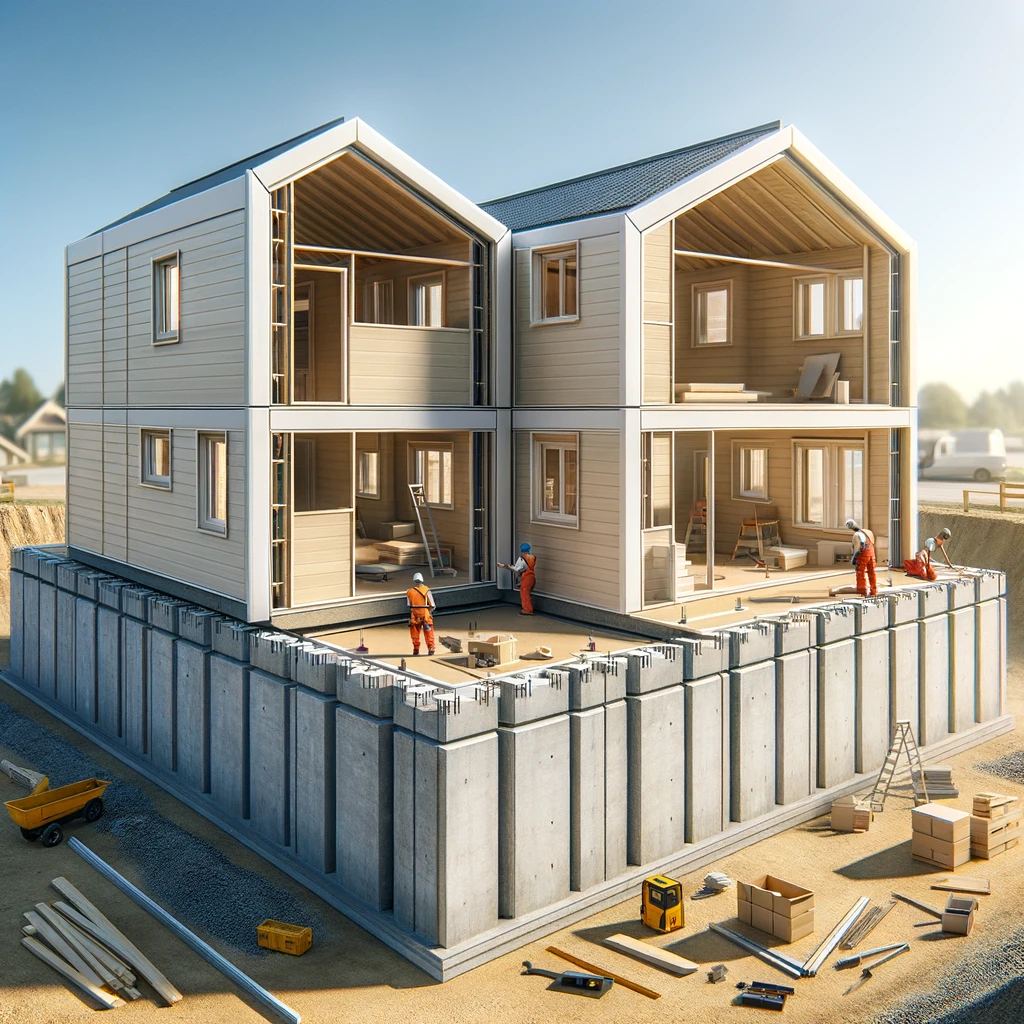Understanding Modular and Manufactured Homes: Financing Challenges and Opportunities
The Distinct Differences Between Modular and Manufactured Homes
Modular homes are constructed in sections at a factory and assembled on-site on a permanent foundation, adhering to local and state building codes. Manufactured homes, built entirely in a factory under the Federal HUD building code, can be placed on permanent or non-permanent foundations.
Telling the difference between a manufactured home and a modular home by just looking at them can be challenging, especially since both types of homes have evolved in terms of design and quality. However, there are a few general indicators that might help distinguish between the two:
Foundation and Undercarriage:
Manufactured Homes: Typically, they are built on a non-removable steel chassis and may have visible undercarriage or a skirting area covering the space between the home and the ground.
Modular Homes: These are usually set on a traditional concrete foundation that’s similar to site-built homes and don’t have a visible steel chassis or undercarriage.
Appearance and Design:
Manufactured Homes: Often come in single or double-wide configurations and might have a more rectangular shape. The roof pitch tends to be lower, and the exterior design may be more simplistic.
Modular Homes: They can be virtually indistinguishable from traditional site-built homes. They offer more variety in design, including multi-story options, higher roof pitches, and diverse architectural styles. 
Transportation:
Manufactured Homes: These homes are often seen transported in whole sections on roads, with transportation tags visible.
Modular Homes: Transported in sections or modules, but once assembled on their foundation, they don’t resemble a structure that has been transported.
HUD Tag vs. Local Building Codes:
Manufactured Homes: Should have a HUD tag or certification label, indicating compliance with federal standards.
Modular Homes: They don’t have HUD tags. Instead, they are built to comply with local and state building codes, and documentation or certification might be available through local building permits and inspections.
Exterior Utilities and Connections:
Manufactured Homes: Utility connections might be more visible, similar to a mobile home.
Modular Homes: Utilities are typically connected in a way that’s similar to site-built homes, often less visible.
Despite these general guidelines, it’s important to note that the lines between manufactured and modular homes can blur, especially with advancements in factory-built housing. Sometimes, the only sure way to differentiate is through looking at the documentation or building permits of the home.
Telling the difference between a manufactured home and a modular home by just looking at them can be challenging, especially since both types of homes have evolved in terms of design and quality. However, there are a few general indicators that might help distinguish between the two:
Foundation and Undercarriage:
Manufactured Homes: Typically, they are built on a non-removable steel chassis and may have visible undercarriage or a skirting area covering the space between the home and the ground. Modular Homes: These are usually set on a traditional concrete foundation that’s similar to site-built homes and don’t have a visible steel chassis or undercarriage. Appearance and Design:
Manufactured Homes: Often come in single or double-wide configurations and might have a more rectangular shape. The roof pitch tends to be lower, and the exterior design may be more simplistic. Modular Homes: They can be virtually indistinguishable from traditional site-built homes. They offer more variety in design, including multi-story options, higher roof pitches, and diverse architectural styles.
Transportation:
Manufactured Homes: These homes are often seen transported in whole sections on roads, with transportation tags visible. Modular Homes: Transported in sections or modules, but once assembled on their foundation, they don’t resemble a structure that has been transported. 
HUD Tag vs. Local Building Codes:
Manufactured Homes: Should have a HUD tag or certification label, indicating compliance with federal standards. Modular Homes: They don’t have HUD tags. Instead, they are built to comply with local and state building codes, and documentation or certification might be available through local building permits and inspections.
Exterior Utilities and Connections:
Manufactured Homes: Utility connections might be more visible, similar to a mobile home. Modular Homes: Utilities are typically connected in a way that’s similar to site-built homes, often less visible.
Despite these general guidelines, it’s important to note that the lines between manufactured and modular homes can blur, especially with advancements in factory-built housing. Sometimes, the only sure way to differentiate is through looking at the documentation or building permits of the home.
Navigating Financing Challenges
Modular homes may face issues such as appraisal difficulties and lender misconceptions, requiring construction loans for both land and home construction. Manufactured homes encounter challenges like strict HUD code compliance, titling issues, and higher interest rates and down payments.
Fannie Mae, Freddie Mac Requirements, and HUD Guidelines for Manufactured Homes
Financing for manufactured homes through Fannie Mae and Freddie Mac involves specific criteria:
Size Requirements: The home must be at least 400 square feet and 12 feet wide. Construction and Installation: Built to HUD Code, on a permanent chassis, and installed on a permanent foundation system. Titling and Land Lease Limitations: Must be titled as real estate. Fannie Mae generally does not purchase manufactured housing loans if the home is on a leased lot or in a leasehold community. The land must typically be owned outright by the homeowner, which can limit financing options for homes not owned with the land. HUD Tag Requirement: The HUD tag, affixed to each section of a manufactured home, certifies compliance with HUD standards, containing information such as the serial number and date of manufacture.
Movement of manufactured homes
There are specific rules and considerations regarding the movement of manufactured homes when using a conforming loan, particularly those backed by Fannie Mae or Freddie Mac. Here’s a summary of the key points:
Movement from the Original Site:
Manufactured homes are expected to be transported directly from the manufacturer to the final site. If a manufactured home has been moved from its original site (where it was first installed), it typically becomes ineligible for a conforming loan. This policy is in place because moving a manufactured home can potentially compromise its structural integrity and may also indicate it was previously used, which can affect its eligibility.
One-Time Move Rule:
The general rule for conforming loans is that the manufactured home should only be moved once – from the factory to the lot where it is to be permanently located. Any subsequent moves after the initial placement can disqualify the home from most conventional financing options.
Documentation and Certification:
Lenders may require specific documentation to prove that the home has not been moved from its original installation site. This might include transport records, installation permits, or other forms of certification.
Financing Limitations for Manufactured Homes vs. Site-Built Homes
Maximum LTV for First-Time Home Buyers: For manufactured homes, the maximum loan-to-value (LTV) ratio is capped at 95% for first-time home buyers, compared to 97% for site-built homes under Fannie Mae’s standard transactions.
Condominium Communities and Manufactured Homes
In condominium communities, manufactured homes may not need to be owned with the land. However, this is an exception and not the norm for financing manufactured homes, as Fannie Mae typically requires the land to be owned by the homeowner. For these communities, both the land and dwelling, must be subject to the condo regime. PERS (Project Eligibility Review Service) approval is required for all condo, co-op, or PUD projects that consist of single-width manufactured homes and for some projects with multi-width manufactured homes.
Tiny Homes
Tiny homes are built to HUD standards. According to the U.S. Department of Housing and Urban Development (HUD), tiny homes that rest on a skid or foundation — or are over 400 square feet — now fall squarely under the HUD manufactured housing standards 1. HUD prohibits the sale and lease of homes that do not meet federal standards, and tiny home builders are now entering a new era of compliance.
In order to be occupied, a tiny home must comply with the standards of, and be approved as one of the following types of structures: a HUD-Code manufactured home (MH), California Residential Code or California Building Code home, factory-built housing (FBH), recreational vehicle (RV), park trailer (PT) or camping cabin (CC).
If a tiny home is not built according HUD standards, it will not qualify for a conforming mortgage, however being built according to HUD standards will not qualify a tiny home for a conforming mortgage in of itself. 
Emerging Solutions and Developer Considerations
The landscape is evolving with a focus on sustainability, affordability, and technology. Developers should consider regional demand, mortgage rates, and material costs. Flexible floor plans, outdoor living spaces, and technology enhancements can improve appeal. Staying informed about trends and regulatory changes in the manufactured and tiny home sectors is crucial for navigating the financing landscape and capitalizing on market opportunities.

Christopher Gibson
NMLS #1910430 | C2 Financial Corp NMLS #135622
Call me: 720-449-6622
Email me: C@ChrisRayGibson.com
